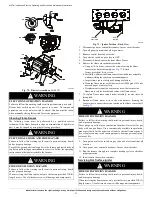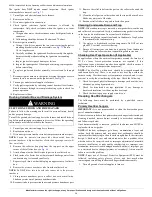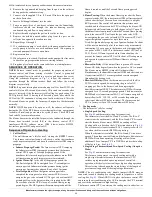
935CA: Installation, Start-up, Operating and Service and Maintenance Instructions
Manufacturer reserves the right to change, at any time, specifications and designs without notice and without obligations.
60
4. Remove the top unused rubber plug from the port on the collector
box opposite the condensate trap.
5. Connect a field supplied 3/8-in. (9.5-mm) ID tube to the open port
on the collector box.
6. Insert a field supplied funnel into the tube.
7. Pour one quart (liter) of anti-freeze solution into the funnel/tube.
Antifreeze should run through the inducer housing, overfill
condensate trap and flow to an open drain.
8. Replace the rubber plug in the port on the collector box.
9. Remove the middle unused rubber plug from the port on the
collector box opposite the condensate trap.
10. Repeat Steps 5 through 8.
11. If a condensate pump is used, check with pump manufacturer to
verify pump is safe for use with antifreeze used. Allow pump to
start and pump anti-freeze to open drain.
12. Replace main door.
13. When furnace is re-started, flush condensate pump with clear water
to check for proper operation before re-starting furnace.
14. Propylene glycol need not be removed before re-starting furnace.
SEQUENCE OF OPERATION
NOTE:
Furnace control must be grounded for proper operation of
furnace control and flame sensing electrode. Control is grounded
through green/yellow wire routed to gas valve and burner box screw.
Using the schematic diagram in
Fig. 76
, follow the sequence of
operation through the different modes. Read and follow the wiring
diagram very carefully.
NOTE:
If a power interruption occurs during a call for heat W/W1, the
control will start a 90-second blower-only ON period two seconds after
power is restored, if the thermostat is still calling for gas heating. The
LED light will flash 12 during the 90-second period, after which the
LED will be ON continuous, as long as no faults are detected. After the
90-second blower-on period, the furnace will respond to the thermostat
normally.
NOTE:
If BTS happens to be open as well, the inducer will operate
during the 90s. If the BTS does not reset during this time, a permanent
lockout will result and power must be cycled to reset. Check BTS and
fault code 26 for more information.
The blower door must be installed for power to be conducted through the
blower door interlock switch ILK to the furnace control CPU,
transformer TRAN, inducer motor IDM, blower motor BLWM,
hot-surface igniter HSI, and gas valve GV.
Sequence of Operation - Heating
1.
Call for Heat:
The wall thermostat “calls for heat”, closing the R
-W/W1
circuit.
The furnace control performs a self-check, verifies the transducer
reads no pressure present, and starts the inducer motor IDM ramp to
prepurge.
a.
Inducer Prepurge Period:
The furnace control CPU ramps up
the inducer motor IDM to prepurge pressure then the furnace
control CPU begins a 15-second prepurge period. If the
transducer fails to reach target pressure the inducer motor IDM
will remain running until target pressure is maintained.
b.
Igniter Warm-Up:
At the end of the prepurge period, the
Hot-Surface Igniter HSI is energized for a 17-second igniter
warm-up period. Inducer maintains pressure during igniter
warm-up or 5 minutes has elapsed. Retry after 15 minutes.
c.
Trial for Ignition:
When the igniter warm-up period is
completed the main gas valve relay contact GVR closes to
energize the gas valve solenoid GV. The gas valve solenoid GV
permits gas flow to the burners where it is ignited by the HSI.
Five seconds after the GVR closes, a 2-second flame proving
period begins. The HSI igniter will remain energized until the
flame is sensed or until the 2-second flame proving period
begins.
d.
Flame Proving:
When the burner flame is proved at the flame
sensor electrode FSE, the inducer motor IDM will increase speed
(after a short delay of 14 seconds on some modes) to a higher
RUN pressure. The control will maintain this pressure once
reached, and the furnace control CPU will begin the blower-ON
delay period while continuing to hold the gas valve GV open. If
the burner flame is not proved within the 2-second flame proving
period, the control CPU will open the gas valve relay GVR,
de-energizing the gas valve solenoid GV. The control CPU will
repeat the ignition sequence for up to three more
Trials-For-Ignition before going to an Ignition-Lockout. Lockout
will be reset automatically after three hours, or by momentarily
interrupting 115 vac power to the furnace, or by interrupting 24
vac power at SEC1 or SEC2 to the furnace control CPU (not at
W, G, R, etc.). If flame is proved when flame should not be
present, the furnace control CPU will lock out of Heating mode
and operate the inducer motor IDM until flame is no longer
proved.
e.
Blower-On-Delay:
If the burner flame is proven a 25-second
blower-ON delay begins from when the gas valve GV is opened.
The blower motor BLWM is turned ON at heat airflow.
Simultaneously, the humidifier terminal HUM and electronic air
cleaner terminal EAC-1 are energized and remain energized
throughout the heating cycle.
f.
Blower-Off-Delay:
When the thermostat is satisfied, the R to
W/W1 circuit is opened, de-energizing the gas valve GV,
stopping gas flow to the burners, and de-energizing the
humidifier terminal HUM. The inducer motor IDM will remain
energized for a 15-second post-purge period. The blower motor
BLWM and air cleaner terminal EAC-1 will remain energized at
heat airflow for 90, 120, 150, or 180 seconds (depending on
selection at blower-OFF delay switches). The furnace control
CPU is factory-set for a 120-second blower-OFF delay.
2.
Cooling mode
The thermostat “calls for cooling”.
a.
Single-Speed Cooling
-
See
Fig. 42
and thermostat wiring for connections
The thermostat closes the R-to-G-and-Y circuits. The R-to- Y
circuit starts the outdoor unit, and the R-to-G-and-Y/Y2 circuits
start the furnace blower motor BLWM on cooling airflow.
Cooling airflow is based on the A/C selection shown in
Fig. 65
.
The electronic air cleaner terminal EAC-1 is energized with 115
vac when the blower motor BLWM is operating.
When the thermostat is satisfied, the R-to-G-and-Y circuits are
opened. The outdoor unit will stop, and the furnace blower motor
BLWM will continue operating at cooling airflow for an
additional 90 sec. Jumper Y/Y2 to DHUM to reduce the cooling
off-delay to 5 sec. See
Fig. 42
.
b.
Single-Stage Thermostat and Two-Speed Cooling (Adaptive
Mode)
-
See
Fig. 42
and thermostat wiring for connections
This furnace can operate a two-speed cooling unit with a
single-stage thermostat because the furnace control CPU
includes a programmed adaptive sequence of controlled
operation, which selects low-cooling or high-cooling operation.
This selection is based upon the stored history of the length of
previous cooling period of the single-stage thermostat.
NOTE:
The air conditioning relay disable jumper ACRDJ must be
connected to enable the adaptive cooling mode in response to a call for
cooling. See
Fig. 42
. When ACRDJ is in place the furnace control CPU
can turn on the air conditioning relay ACR to energize the Y/Y2 terminal
and switch the outdoor unit to high-cooling.
The furnace control CPU can start up the cooling unit in either low- or































